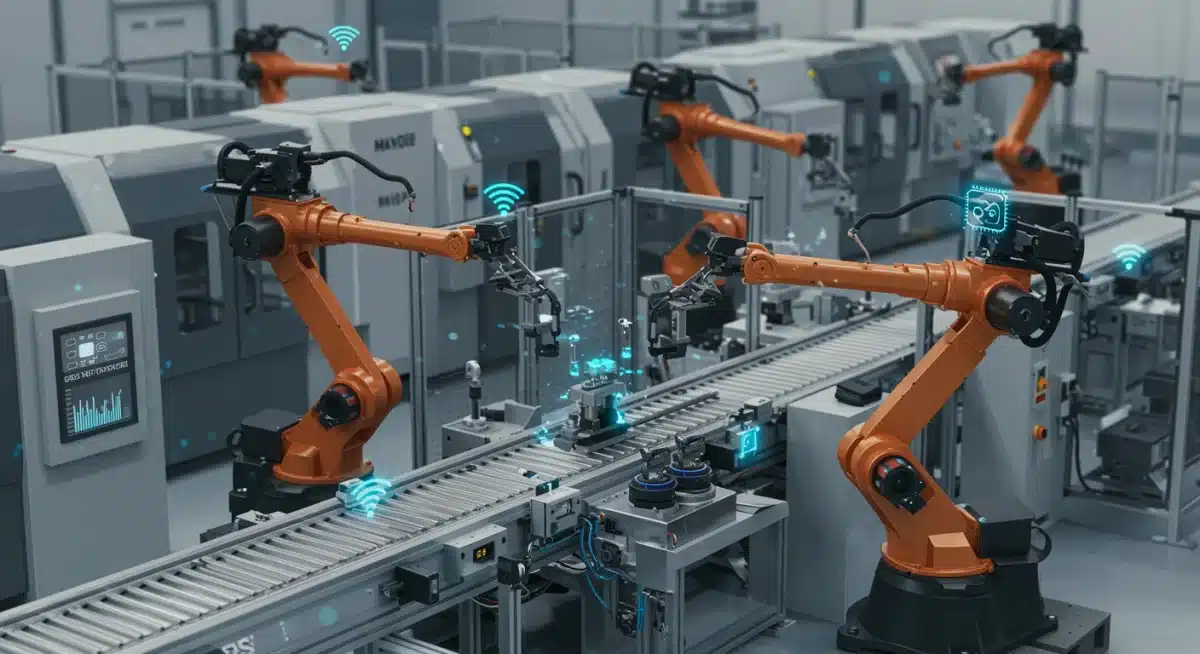Edge AI’s Ascent: 6 Practical US Business Applications in 2025

Edge AI is revolutionizing how US businesses process data by enabling real-time analytics and decision-making directly at the source, significantly enhancing operational efficiency and fostering rapid innovation across diverse sectors.
The Rise of Edge AI: An Insider Look at 6 Practical Applications for US Businesses in the Next 12 Months is not just a technological buzzword; it represents a fundamental shift in how data is processed, analyzed, and acted upon. As businesses in the United States strive for greater efficiency, faster decision-making, and enhanced customer experiences, the decentralization of artificial intelligence from the cloud to the ‘edge’ of the network is becoming increasingly critical. This transformation promises to unlock new levels of performance and innovation across industries, from manufacturing to retail, and beyond.
Understanding the Edge AI Paradigm Shift
Edge AI refers to the deployment of AI algorithms directly on local devices, sensors, and gateways, rather than relying solely on centralized cloud servers. This approach minimizes latency, reduces bandwidth consumption, and enhances data privacy, making it ideal for applications where real-time processing is paramount. The shift from cloud-centric AI to edge-centric AI is driven by the sheer volume of data generated by an ever-growing number of connected devices, often referred to as the Internet of Things (IoT).
Historically, AI processing required sending vast amounts of data to powerful cloud data centers for analysis. While effective for many tasks, this model introduces delays and can be inefficient for time-sensitive operations. Edge AI addresses these limitations by bringing the computational power closer to the data source, enabling immediate insights and autonomous actions. This paradigm shift is particularly impactful for US businesses operating in environments with intermittent connectivity or those requiring instantaneous responses, such as autonomous vehicles or critical infrastructure monitoring.
The Core Benefits of Edge AI
The advantages of implementing Edge AI are multifaceted and directly translate into tangible business benefits. These benefits extend beyond mere technological advancement, impacting operational costs, security posture, and competitive differentiation.
- Reduced Latency: Processing data locally eliminates the round-trip journey to the cloud, significantly decreasing response times.
- Enhanced Security and Privacy: Sensitive data can be processed and analyzed on-device, reducing the risk of exposure during transmission to the cloud.
- Lower Bandwidth Costs: Only essential or aggregated data needs to be sent to the cloud, cutting down on data transfer expenses.
- Improved Reliability: Edge devices can operate autonomously even when network connectivity to the cloud is interrupted.
- Scalability: Deploying AI at the edge allows for flexible scaling of operations without overloading central cloud infrastructure.
In essence, Edge AI empowers businesses to make smarter, faster decisions, often without human intervention, leading to more agile and resilient operations. This foundational understanding is crucial for appreciating the practical applications emerging in the US market.
Predictive Maintenance in Manufacturing and Industrial IoT
One of the most compelling applications of Edge AI for US businesses lies within the manufacturing sector, specifically in predictive maintenance. Traditional maintenance schedules are often reactive or time-based, leading to either unexpected downtime or unnecessary component replacements. Edge AI revolutionizes this by enabling real-time monitoring and analysis of machinery performance, predicting potential failures before they occur.
By deploying AI models directly on industrial sensors and machinery, data on vibration, temperature, pressure, and acoustic signatures can be analyzed instantaneously. These edge devices can detect subtle anomalies that indicate impending equipment failure, triggering alerts or even initiating automated corrective actions. This proactive approach significantly reduces downtime, extends equipment lifespan, and optimizes maintenance schedules, leading to substantial cost savings and increased operational efficiency for US manufacturers.

Consider a large-scale automotive plant where hundreds of robotic arms operate continuously. A slight deviation in a robot’s motor vibration, undetectable by human operators, could signal an imminent bearing failure. An Edge AI system can identify this anomaly immediately, alert maintenance teams, and even suggest the optimal time for repair during a scheduled break, preventing a costly and disruptive breakdown during peak production hours. This level of foresight is invaluable in maintaining competitive edge.
Optimizing Factory Operations with Edge AI
Beyond preventing failures, Edge AI in manufacturing also contributes to overall operational optimization. By continuously monitoring production lines, edge devices can identify bottlenecks, inefficiencies, and quality control issues in real-time. This not only enhances product quality but also streamlines the entire manufacturing process.
- Real-time Quality Control: AI-powered cameras at the edge can inspect products for defects as they move down the assembly line, identifying and rejecting faulty items instantly.
- Energy Management: Edge AI can monitor energy consumption of various machines and optimize their operation to reduce waste and lower utility costs.
- Supply Chain Visibility: Integrating edge sensors into the supply chain allows for real-time tracking of materials and finished goods, improving logistics and inventory management.
The ability to act on data at the point of creation, rather than waiting for cloud processing, gives US manufacturers a significant advantage in a highly competitive global market. It transforms factories into intelligent, self-optimizing ecosystems.
Enhanced Customer Experiences in Retail and Hospitality
The retail and hospitality sectors in the US are undergoing a massive transformation, driven by the demand for personalized and seamless customer experiences. Edge AI is playing a pivotal role in this evolution, enabling businesses to understand and respond to customer needs in real-time, directly within their physical spaces.
From smart stores to intelligent hotels, Edge AI applications are improving everything from inventory management to personalized marketing. Imagine a retail store where cameras equipped with edge AI can anonymously analyze customer traffic patterns, identify popular product displays, and even detect queues forming at checkout. This real-time data allows store managers to optimize staffing levels, rearrange merchandise for better engagement, and send targeted promotions to customers’ mobile devices based on their in-store behavior.
In hospitality, Edge AI can power smart rooms that learn guest preferences, adjusting lighting, temperature, and entertainment options automatically. Facial recognition (with appropriate privacy safeguards and consent) could enable seamless check-ins, while AI-powered chatbots on edge devices could provide instant concierge services, answering questions and fulfilling requests without human intervention. These applications create highly personalized and efficient experiences that foster customer loyalty.
Personalized Marketing and Inventory Management
The power of Edge AI in retail extends to highly personalized marketing strategies and more efficient inventory management. By processing data locally, businesses can react instantly to changing conditions.
- Dynamic Pricing: Edge AI can analyze local demand and competitor pricing in real-time to adjust product prices for maximum profitability.
- Hyper-Personalized Recommendations: In-store kiosks or digital signage can offer product recommendations based on a customer’s immediate browsing behavior and past purchases, processed at the edge.
- Automated Stock Replenishment: Edge sensors on shelves can detect low stock levels and trigger automatic reorder alerts, minimizing out-of-stock situations.
These capabilities allow US retailers to move beyond generic marketing and inventory practices, offering a more responsive and tailored shopping experience that drives sales and reduces waste.
Autonomous Vehicles and Smart Transportation
The development of autonomous vehicles (AVs) and smart transportation systems is perhaps one of the most visible and impactful applications of Edge AI. For AVs to operate safely and reliably, they must process vast amounts of sensor data (from cameras, LiDAR, radar, etc.) in milliseconds to make critical decisions about navigation, obstacle avoidance, and pedestrian detection. Sending all this data to the cloud for processing is simply not feasible due to latency constraints and safety implications.
Edge AI processors within autonomous vehicles enable them to perform real-time perception, planning, and control. This means the car can understand its surroundings, predict the behavior of other road users, and react instantly to dynamic conditions without waiting for instructions from a remote server. This local processing capability is fundamental to the safety and reliability of self-driving technology, paving the way for wider adoption in the US.
![]()
Beyond individual vehicles, Edge AI is also transforming broader smart transportation infrastructure. Traffic lights equipped with edge AI can dynamically adjust timing based on real-time traffic flow, emergency vehicle detection, and pedestrian presence, optimizing urban mobility and reducing congestion. Public transit systems can use edge AI for real-time passenger counting and predictive maintenance of trains and buses, ensuring more efficient and reliable services.
Healthcare Monitoring and Diagnostics at the Edge
In the healthcare sector, Edge AI is poised to revolutionize patient monitoring, diagnostics, and even remote care, particularly in the US where healthcare access and efficiency are critical concerns. Wearable devices, smart sensors in hospitals, and remote patient monitoring systems can generate continuous streams of vital sign data, activity levels, and other health metrics. Processing this data at the edge offers immediate insights and can trigger timely interventions.
For example, an Edge AI-powered wearable device could continuously monitor a patient with a heart condition, detecting subtle changes in their ECG patterns that might indicate an impending cardiac event. Instead of sending all raw data to a distant cloud for analysis, the edge device processes it locally, alerting the patient or their care provider immediately if a critical anomaly is detected. This drastically reduces response times and can be life-saving, especially in remote areas or for elderly patients living alone.
Improving Clinical Workflows and Remote Care
Edge AI also streamlines clinical workflows and enhances the capabilities of remote patient care, making healthcare more accessible and efficient.
- Real-time Diagnostic Assistance: AI models on edge devices can analyze medical images (e.g., X-rays, MRIs) or lab results locally, providing preliminary diagnostic insights to clinicians more quickly.
- Smart Hospital Operations: Edge AI can optimize hospital resource allocation, track equipment, and monitor patient flow to improve operational efficiency and patient safety.
- Personalized Medication Management: Smart dispensers with edge AI can ensure patients take their medication correctly and on schedule, sending alerts if doses are missed.
The ability to bring advanced analytical capabilities directly to the point of care, whether in a hospital or a patient’s home, represents a significant leap forward for US healthcare.
Smart Agriculture and Precision Farming
The agricultural industry in the US faces numerous challenges, from optimizing crop yields to managing resources efficiently and adapting to climate change. Edge AI is emerging as a powerful tool for smart agriculture and precision farming, enabling farmers to make data-driven decisions directly on their farms.
Drones and ground-based sensors equipped with Edge AI can autonomously monitor crop health, detect pests and diseases, and assess soil conditions in real-time. Instead of uploading massive image and sensor data files to the cloud for analysis, the AI processes this information on the device, immediately identifying problem areas that require intervention. This allows for targeted application of water, fertilizers, and pesticides, reducing waste and increasing efficiency.
For instance, an Edge AI-enabled drone can fly over a field, identify specific plants showing signs of stress or disease, and then immediately relay precise GPS coordinates to an automated sprayer, which can then apply treatment only where needed. This level of precision minimizes environmental impact and maximizes resource utilization, directly benefiting US farmers striving for sustainable and profitable operations.
Optimizing Resource Usage and Yields
The application of Edge AI in agriculture leads to significant improvements in resource management and overall farm productivity.
- Automated Irrigation: Edge sensors can measure soil moisture levels and trigger irrigation systems only when necessary, conserving water.
- Pest and Disease Detection: AI-powered cameras can identify early signs of infestations or diseases, allowing for rapid, localized treatment.
- Yield Prediction: By analyzing various environmental and growth factors, edge AI can provide more accurate yield forecasts, aiding in harvest planning and market strategy.
These advancements empower US farmers to operate more intelligently, ensuring food security and economic viability in an increasingly complex global market.
Intelligent Security and Surveillance Systems
Security and surveillance are critical concerns for businesses and public spaces across the US. Traditional surveillance systems often rely on human monitoring or cloud-based video analytics, which can be prone to delays and high bandwidth requirements. Edge AI is transforming this landscape by enabling intelligent, real-time threat detection and response directly at the camera or sensor level.
Edge AI-powered security cameras can perform advanced video analytics locally, identifying suspicious activities, recognizing unauthorized individuals, or detecting anomalies without sending all video footage to a central server. This allows for immediate alerts in critical situations, such as detecting an intruder in a restricted area or identifying a forgotten package in a public space. The system can then trigger alarms, notify security personnel, or even activate automated countermeasures.
Moreover, Edge AI can enhance privacy by processing video data on-device and only transmitting metadata or alerts, rather than raw video feeds, to the cloud. This reduces the risk of sensitive information being compromised and helps businesses comply with evolving data privacy regulations, a growing concern for US enterprises. The ability to monitor large areas with intelligent, autonomous systems significantly boosts security posture.
Proactive Threat Detection and Response
The real-time capabilities of Edge AI in security systems enable a proactive approach to threat detection and management.
- Anomaly Detection: AI can learn normal patterns of behavior and flag any deviations, such as a person loitering in an unusual spot or entering a forbidden zone.
- Access Control: Facial recognition or gait analysis at the edge can verify identities for secure access to facilities, replacing traditional key cards.
- Perimeter Security: Edge sensors can detect breaches of perimeters, distinguishing between genuine threats and harmless wildlife, reducing false alarms.
These intelligent systems provide US businesses with a more robust, efficient, and responsive security infrastructure, protecting assets and ensuring safety.
| Key Application | Business Impact |
|---|---|
| Predictive Maintenance | Reduces downtime, extends equipment life, cuts operational costs in manufacturing. |
| Smart Retail & Hospitality | Enhances customer experience, personalizes marketing, optimizes inventory. |
| Autonomous Vehicles | Enables real-time decision-making for safe navigation and smart urban mobility. |
| Healthcare Monitoring | Provides immediate patient insights, supports remote care, and improves diagnostics. |
Frequently Asked Questions About Edge AI
Edge AI processes data directly on local devices or sensors near the data source, minimizing latency and bandwidth use. Cloud AI, conversely, sends data to remote data centers for processing. The key difference lies in where the computational work is performed, with Edge AI offering faster, more localized insights.
US businesses are adopting Edge AI for its ability to enable real-time decision-making, enhance data privacy, reduce operational costs, and ensure continuous operation even with intermittent network connectivity. These benefits are crucial for maintaining competitiveness and fostering innovation in various industries.
While Edge AI can enhance security by processing sensitive data locally, it also introduces new vulnerabilities at the edge devices themselves. Robust security measures, including encryption, secure boot processes, and regular updates, are essential to protect these distributed AI systems from cyber threats.
Absolutely. Edge AI solutions are becoming more accessible and scalable. SMBs can leverage Edge AI for tasks like optimized inventory management in retail, localized anomaly detection in small manufacturing plants, or smart building management, leading to significant efficiency gains without massive infrastructure investments.
Deploying and managing Edge AI requires a blend of skills, including expertise in AI/machine learning, IoT platforms, network engineering, and cybersecurity. Companies often look for professionals who can bridge the gap between software development and hardware integration, along with strong data analysis capabilities.
Conclusion
The trajectory of Edge AI is undeniable, and its profound impact on US businesses is just beginning to unfold. From optimizing complex manufacturing processes to personalizing customer experiences in retail, enhancing public safety, and revolutionizing healthcare, the practical applications are diverse and transformative. The ability to process data at the source, make instantaneous decisions, and operate with greater autonomy offers a competitive edge that businesses cannot afford to ignore. As the technology matures and becomes more accessible, we can expect even wider adoption and innovative applications to emerge across every sector of the US economy, solidifying Edge AI’s role as a cornerstone of future digital strategies.





